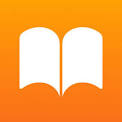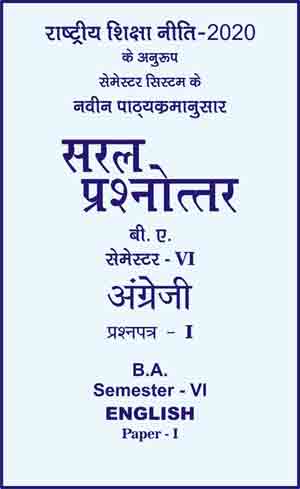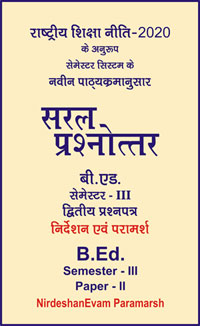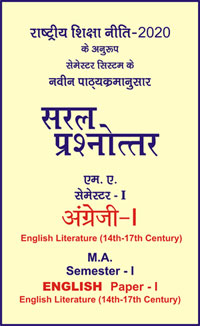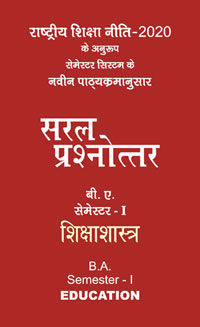|
बी ए - एम ए >> बीए सेमेस्टर 6 अंग्रेजी पेपर 1 बीए सेमेस्टर 6 अंग्रेजी पेपर 1सरल प्रश्नोत्तर समूह
|
|
||||||
बीए सेमेस्टर 6 अंग्रेजी पेपर 1
Chapter 14 - Margaret Atwood: Spellings
Objective Type Questions
For each of the following questions, four alternatives are given for the answer. Only one of them is correct. Choose the correct alternative.
-
What is Margaret Atwood's full name?
(a) Margaret Eleanor Atwood
(b) Margaret Anne Atwood
(c) Margaret Elizabeth Atwood
(d) Margaret Louise Atwood -
In which country was Margaret Atwood born?
(a) Canada
(b) United States
(c) England
(d) Australia -
Which year was Margaret Atwood born?
(a) 1939
(b) 1940
(c) 1950
(d) 1965 -
Margaret Atwood is best known for her contributions to which literary genre?
(a) Prose Fiction
(b) Romance
(c) Mystery
(d) Historical Fiction -
What is the title of Margaret Atwood's most famous novel, a dystopian narrative set in the Republic of Gilead?
(a) The Handmaid's Tale
(b) Oryx and Crake
(c) Alias Grace
(d) Cat's Eye -
In addition to being a novelist, Margaret Atwood is also known for her work in which other artistic medium?
(a) Painting
(b) Music
(c) Poetry
(d) Theater -
Margaret Atwood served as the Writer-in-Residence at which university?
(a) Harvard University
(b) Oxford University
(c) University of Toronto
(d) Stanford University -
Which Margaret Atwood novel is set in the fictional town of Port Ticonderoga and explores themes of power and control?
(a) The Edible Woman
(b) The Robber Bride
(c) Cat's Eye
(d) Power Politics -
In which year did Margaret Atwood publish her debut novel, "The Edible Woman"?
(a) 1969
(b) 1970
(c) 1975
(d) 1980 -
Margaret Atwood has been a vocal advocate for which environmental issue?
(a) Deforestation
(b) Climate Change
(c) Ocean Pollution
(d) Endangered Species -
Margaret Atwood was awarded the Golden Booker Prize in 2019 for which novel?
(a) The Handmaid's Tale
(b) Cat's Eye
(c) Oryx and Crake
(d) The Blind Assassin -
Which literary award did Margaret Atwood receive for her novel "The Blind Assassin"?
(a) Nobel Prize in Literature
(b) Man Booker Prize
(c) Pulitzer Prize for Fiction
(d) Governor General's Award -
In which year did Margaret Atwood publish "Oryx and Crake," the first book in the MaddAddam trilogy?
(a) 1999
(b) 2003
(c) 2007
(d) 2011 -
What is the title of Margaret Atwood's dystopian trilogy that includes "Oryx and Crake," "The Year of the Flood," and "MaddAddam"?
(a) The Handmaid's Trilogy
(b) The Oryx Trilogy
(c) The MaddAddam Trilogy
(d) The Crake Chronicles -
What are the major themes and motifs in the poem?
(a) Female Suppression, Feminism, Children Violence
(b) Children's game differences between boy and girl
(c) Mother's love for children, her caring, children's activity
(d) All of the above -
"How do you learn to ... ... ..." Complete it.
(a) Word
(b) Spell
(c) Alphabet
(d) Language -
The poem "Spelling God" questions:
(a) the existence of God
(b) the way language limits our understanding of the divine
(c) the role of religion in a secular society
(d) all of the above -
What is a central theme of "Spelling" by Margaret Atwood?
(a) Nature
(b) Technology
(c) Power of words
(d) Historical events -
What does the act of the daughter learning to spell symbolize in the poem?
(a) Educational development
(b) Innocence of youth
(c) Beginning of understanding
(d) All of the above -
How are witchcraft and writing connected in "Spelling"?
(a) As hobbies
(b) As historical practices
(c) As types of power connected with words
(d) As entertainment forms -
What does the witch character in "Spelling" symbolize?
(a) Fear
(b) Nature’s wrath
(c) Women’s power and voice
(d) Mystery -
How is the power of words particularly potent for women in "Spelling"?
(a) It’s a form of entertainment
(b) It’s often taken away from them
(c) It’s a hobby
(d) It’s a tradition -
The line “A word after a word/ after a word is power” implies that:
(a) Words are meaningless
(b) Words build upon each other to create power
(c) Words are difficult to understand
(d) Words are used for decoration -
What do the plastic letters in the poem represent?
(a) Childhood toys
(b) Colorful decorations
(c) Building blocks of knowledge
(d) Confusion -
What does the act of ‘spelling’ represent in the poem?
(a) A routine activity
(b) The power of creating and influencing
(c) A game
(d) A school lesson -
In "Spelling," the witch’s executioners prevent her from speaking to:
(a) Punish her
(b) Take away her power
(c) Follow a ritual
(d) Protect themselves -
The narrator in "Spelling" reflects on women who:
(a) Enjoyed witchcraft
(b) Chose not to have children to focus on writing
(c) Preferred to live alone
(d) Were famous poets -
What does the color symbolism in the poem (red, blue, yellow) represent?
(a) Different emotions
(b) Seasons
(c) Basic elements of life
(d) Different landscapes -
The poem appears in -
(a) True stories
(b) Short stories
(c) Magazine
(d) None of these -
"Spelling" by Margaret Atwood can be described as a:
(a) Love poem
(b) Narrative poem
(c) Humorous poem
(d) Feminist poem -
The burning of the witch in the poem symbolizes:
(a) Warmth
(b) Historical persecution of women
(c) Celebration
(d) Natural disasters -
Atwood’s "Spelling" primarily explores themes related to:
(a) Science and technology
(b) Women’s empowerment and language
(c) Travel and adventure
(d) Food and culture -
In the poem, the act of the child learning to spell is paralleled with:
(a) A witch casting spells
(b) Running a marathon
(c) Painting a picture
(d) Cooking a meal -
The line “my daughter” in the poem primarily focuses on:
(a) A familial relationship
(b) The narrator’s friend
(c) A symbolic figure
(d) A historical character -
What does the phrase “mainline words” in "Spelling" suggest about writing?
(a) It is addictive
(b) It is essential for life
(c) It is a pastime
(d) Both (a) and (b) -
The poem "Spelling" utilizes which literary device extensively?
(a) Irony
(b) Symbolism
(c) Onomatopoeia
(d) Hyperbole -
What does the imagery of ‘thighs tied together’ symbolize in "Spelling"?
(a) Physical restraint
(b) Societal constraints on women
(c) A traditional practice
(d) Both (a) and (b) -
"Spelling" by Atwood is set in which context?
(a) A futuristic world
(b) A historical setting
(c) A domestic scene
(d) A fantasy realm -
The motif of the witch in "Spelling" primarily represents:
(a) Superstition
(b) Female resilience and power
(c) Fear of the unknown
(d) Ancient rituals -
"Spelling" addresses the theme of:
(a) Childhood innocence
(b) Environmental issues
(c) Economic development
(d) Female voice and empowerment -
The structure of "Spelling" serves to:
(a) Confuse the reader
(b) Reflect the chaos of life
(c) Illustrate the evolution of understanding
(d) Mimic traditional poetic forms -
The ending of "Spelling" suggests a sense of:
(a) Despair
(b) Hope and continuity
(c) Nostalgia
(d) Anger -
The poem "Spelling" begins with the words -
(a) My daughter plays on the floor
(b) Red, blue and hard yellow
(c) Learning how to spell
(d) How to make spells -
With whom was the child playing on the floor?
(a) With a ball
(b) Plastic letters
(c) With a doll
(d) None of these -
What are the colors mentioned in the poem?
(a) White, Black and Yellow
(b) Red, Blue and Hard Yellow
(c) Purple, Pink and White
(d) Orange, Green and Yellow -
In this poem "Spelling", 'Red, blue and hard yellow' is called -
(a) Primary colours
(b) Solid colours
(c) Middle colours
(d) None of these -
The poem "Spelling" is written by -
(a) Virginia Woolf
(b) Mary Webster
(c) Margaret Atwood
(d) None of these -
Margaret Atwood in her poem presented -
(a) The conflict between mother and daughter
(b) The conflict between mother and child
(c) The conflict between motherhood and profession
(d) The Conflict between mother and her mother -
Which World War beings during Atwood's poem?
(a) World War First
(b) World War Second
(c) At the end of First World War
(d) None of these -
Which figure of speech is used in this poem "Spelling"?
(a) Simile
(b) Personification
(c) Metaphor
(d) Apostrophe -
"Your ... ... ... naming, your ... ... ... name your ... ... ... word". What is word, which is used the same here?
(a) Second
(b) First
(c) Third
(d) Good -
"My daughter place on the ... ... ..." complete this line with the word.
(a) Home
(b) Floor
(c) Room
(d) School -
What does the poet tell in the second stanza of the poem?
(a) The poet talks about the conditions of being a woman
(b) The poet talks about the conditions of Politics
(c) The poet is very sad for her child
(d) The poet talks about her mother's life -
In the Vth Stanza, the poet used this word 'Spell' what is it?
(a) Pun
(b) Satire
(c) Hyperbole
(d) Metonomy -
'A word after a word, after a word ... ... ...' Complete it with word.
(a) Spelling
(b) Power
(c) War
(d) Floor -
What does the poet say at the last in these lines "Your first naming ... ... ... first word"?
(a) She says that no one can learn the alphabets
(b) She says that no one can name himself though male and female
(c) She says that no one can take care for first name
(d) She says that her first name is very bad name -
Who is the mother in the poem "Spelling"?
(a) Poet herself
(b) Poet Mother
(c) Mother Teresa
(d) Other Poet -
The word 'ancestress' is used the reference of -
(a) Margaret Atwood
(b) Many Webster
(c) Virginia Woolf
(d) None of these
|
|||||

 i
i 

